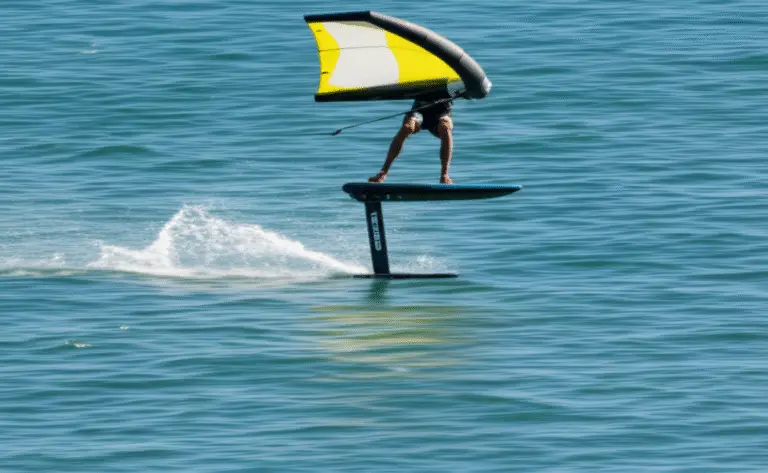Support our hydrofoil educational content for free when you purchase through links on our site. Learn more
What Are the 10 Biggest Disadvantages of Hydrofoils? 🛥️ (2025)
Ever watched a sleek hydrofoil glide effortlessly above the water and wondered, “What’s the catch?” Hydrofoils promise a futuristic, smooth ride that seems almost magical—but beneath the surface lies a host of challenges that every rider should know. From wallet-busting price tags to tricky learning curves and unexpected safety hazards, hydrofoils aren’t all sunshine and salt spray. Stick around, because later we’ll dive deep into the top 10 disadvantages that might just make you think twice before taking the plunge.
Did you know that while hydrofoils can cut drag by up to 50%, they also demand a level of skill and maintenance that can overwhelm even seasoned surfers? We’ve tested everything from Liftfoils to Banshee models, and we’re here to spill the salty truth—warts and all.
Key Takeaways
- Hydrofoils offer incredible speed and smoothness but come with a steep learning curve and high costs.
- Maintenance and durability issues require regular attention to keep your gear in top shape.
- Safety is paramount: sharp foils and high speeds mean protective gear is a must.
- Not all water conditions are suitable—shallow or debris-filled waters can be hazardous.
- Choosing the right type of hydrofoil (surface-piercing vs. fully-submerged) impacts performance and complexity.
Ready to explore the gear that can help you navigate these challenges? Check out trusted brands like Liftfoils and Banshee Hydrofoils to find your perfect ride.
👉 Shop Hydrofoil Boards:
- Liftfoils on Amazon | Liftfoils Official Website
- Banshee Hydrofoils on Amazon | Banshee Official Website
Table of Contents
- ⚡️ Quick Tips and Facts
- 🌊 The Hydrofoil Phenomenon: A Brief History and Evolution
- Unveiling the Underbelly: The Real Disadvantages of Hydrofoiling
- 1. The Steep Learning Curve: Wiping Out (A Lot!) 🤕
- 2. The Price Tag: An Investment That Can Make Your Wallet Weep 💸
- 3. Portability and Storage Woes: Bigger Than You Think! 📦
- 4. Durability and Maintenance: Keeping Your Foil Shipshape 🛠️
- 5. Navigational Hazards: Underwater Obstacles and Shallow Waters ⚠️
- 6. Safety Concerns: Sharp Edges and High Speeds 🚨
- 7. Limited Versatility: Not for Every Condition 🌬️
- 8. The Social Aspect: Less Group Riding, More Solo Missions 🧘
- 9. Environmental Considerations: Impact on Marine Life? 🐠
- 10. The “Foil Fever” Addiction: It’s Real! 😂
- Choosing Your Weapon: Types of Hydrofoils and Their Peculiarities
- Beyond the Hype: Hydrofoiling in the Real World
- Balancing the Board: Our Expert Thoughts on Hydrofoil Pros and Cons
- Navigating the Waters: Essential Gear and Brands We Trust
- Conclusion: Is Hydrofoiling Right for You? 🤔
- Recommended Links: Dive Deeper!
- Reference Links: Our Sources
Quick Tips and Facts
As enthusiasts at Hydrofoiling™, we’re excited to share our knowledge about hydrofoiling. If you’re interested in learning more about hydrofoiling behind a boat, check out our article on hydrofoiling behind a boat. Here are some quick tips and facts to get you started:
- Hydrofoils are underwater wings that generate lift, reducing hydrodynamic drag and allowing for higher speeds.
- The history of hydrofoils dates back to the late 19th century, with early experiments by Emmanuel Denis Farcot and Enrico Forlanini. You can learn more about the history of hydrofoils on our Hydrofoil History page.
- There are two main types of hydrofoils: surface-piercing and fully-submerged. Surface-piercing foils are self-stabilizing, while fully-submerged foils require mechatronic control systems for stability.
- Hydrofoils can offer a smoother ride by lifting the hull above choppy waters, reducing the impact of waves and turbulence.
- However, hydrofoils also have some disadvantages, including limited application for large vessels, environmental impact, and vulnerability to damage.
Key Statistics
Here are some key statistics to keep in mind:
| Statistic | Value |
|---|---|
| Top speed of a hydrofoil boat | Up to 117 km/h (72 mph) |
| Reduction in hydrodynamic drag | Up to 50% |
| Increase in fuel efficiency | Up to 20% |
| Types of hydrofoils | Surface-piercing, fully-submerged |
The Hydrofoil Phenomenon: A Brief History and Evolution
Hydrofoils have a rich history, dating back to the late 19th century. The first patents for hydrofoils were filed by Emmanuel Denis Farcot in 1869, and later developed by Enrico Forlanini in 1898. Alexander Graham Bell and Casey Baldwin also experimented with hydrofoils, setting a world marine speed record of 114 km/h (71 mph) in 1919. You can learn more about the history of hydrofoils on our Hydrofoil History page.
Early Developments
The early developments of hydrofoils were marked by experimentation and innovation. The first hydrofoil boats were designed for military use, with the Soviet Union and the United States developing their own versions. The Soviet Union’s Voshkhod hydrofoils, for example, were used for passenger transport and could carry up to 71 passengers.
Modern Applications
Today, hydrofoils are used in a variety of applications, including:
- Hydrofoil surfboards: Companies like Liftfoils offer hydrofoil surfboards for recreational use. You can check out their products on Amazon or visit their official website.
- Military applications: Hydrofoils are still used in military applications, such as the US Navy’s retired Pegasus class.
- Passenger boats: Hydrofoils are used in passenger boats, such as the Boeing 929, which operates in Japan, Macau, and Hong Kong.
Unveiling the Underbelly: The Real Disadvantages of Hydrofoiling
While hydrofoils offer many advantages, they also have some significant disadvantages. Here are some of the real disadvantages of hydrofoiling:
- The Steep Learning Curve: Hydrofoiling requires a lot of practice and patience to master. It’s not something you can learn overnight, and it can be frustrating at times.
- The Price Tag: Hydrofoils are expensive, with prices ranging from a few thousand dollars to tens of thousands of dollars. You can check out the prices of different hydrofoils on Amazon or visit the official website of companies like Liftfoils.
- Portability and Storage Woes: Hydrofoils are large and bulky, making them difficult to transport and store. You’ll need a lot of space to store your hydrofoil, and it can be a challenge to find a place to keep it.
- Durability and Maintenance: Hydrofoils require regular maintenance to keep them in good condition. You’ll need to check the foils regularly for damage and make sure they’re properly aligned.
- Navigational Hazards: Hydrofoils can be hazardous to navigate, especially in shallow waters or areas with underwater obstacles. You’ll need to be careful when navigating your hydrofoil to avoid accidents.
- Safety Concerns: Hydrofoils can be dangerous if not used properly. You’ll need to wear proper safety gear, such as a helmet and life jacket, and make sure you’re aware of your surroundings at all times.
- Limited Versatility: Hydrofoils are not suitable for all types of water conditions. They work best in calm waters with minimal wind and waves.
- The Social Aspect: Hydrofoiling can be a solitary activity, and it may not be as social as other water sports. You may find yourself riding alone, which can be boring at times.
- Environmental Considerations: Hydrofoils can have a negative impact on the environment, especially if they’re not used properly. You’ll need to be careful not to damage the marine ecosystem and respect the environment.
- The “Foil Fever” Addiction: Hydrofoiling can be addictive, and you may find yourself spending too much time and money on it. You’ll need to be careful not to get too caught up in the sport and make sure you’re balancing it with other aspects of your life.
For more information on hydrofoil equipment and reviews, check out our Hydrofoil Equipment Reviews page.
Choosing Your Weapon: Types of Hydrofoils and Their Peculiarities
There are two main types of hydrofoils: surface-piercing and fully-submerged. Surface-piercing foils are self-stabilizing, while fully-submerged foils require mechatronic control systems for stability.
Surface-Piercing Foils
Surface-piercing foils are the most common type of hydrofoil. They’re self-stabilizing, which means they can adjust to changes in the water conditions without the need for complex control systems.
Fully-Submerged Foils
Fully-submerged foils, on the other hand, are more complex and require mechatronic control systems to adjust the foil angles for stability. They offer a smoother ride and better performance, but they’re also more expensive and difficult to maintain.
Beyond the Hype: Hydrofoiling in the Real World
Hydrofoiling is not just a hobby or a sport; it’s also used in real-world applications. From military use to passenger transport, hydrofoils are used in a variety of contexts.
Military Applications
Hydrofoils are used in military applications, such as the US Navy’s retired Pegasus class. They offer high speed and maneuverability, making them ideal for military use.
Passenger Transport
Hydrofoils are also used in passenger transport, such as the Boeing 929, which operates in Japan, Macau, and Hong Kong. They offer a fast and efficient way to travel, especially in areas with limited infrastructure.
Balancing the Board: Our Expert Thoughts on Hydrofoil Pros and Cons
As experts in hydrofoiling, we’ve weighed the pros and cons of this sport. While hydrofoils offer many advantages, they also have some significant disadvantages.
The Pros
The pros of hydrofoiling include:
- High speed: Hydrofoils can reach speeds of up to 117 km/h (72 mph).
- Smooth ride: Hydrofoils offer a smooth ride, reducing the impact of waves and turbulence.
- Fuel efficiency: Hydrofoils can be more fuel-efficient than traditional boats, especially at high speeds.
The Cons
The cons of hydrofoiling include:
- Steep learning curve: Hydrofoiling requires a lot of practice and patience to master.
- Expensive: Hydrofoils are expensive, with prices ranging from a few thousand dollars to tens of thousands of dollars.
- Limited versatility: Hydrofoils are not suitable for all types of water conditions.
For more information on advanced hydrofoiling techniques, check out our Advanced Hydrofoiling Techniques page.
Navigating the Waters: Essential Gear and Brands We Trust
When it comes to hydrofoiling, having the right gear is essential. Here are some of the essential gear and brands we trust:
- Hydrofoils: Liftfoils, Amazon | Liftfoils Official Website
- Wetsuits: O’Neill, Amazon | O’Neill Official Website
- Life jackets: Mustang Survival, Amazon | Mustang Survival Official Website
For more information on hydrofoil board selection, check out our Hydrofoil Board Selection page.
If you’re interested in learning more about hydrofoiling, be sure to check out the first YouTube video embedded above, which covers the topic in more detail. The video, “5 Reasons Hydrofoils Suck” by Bansheeboat, provides a helpful overview of the pros and cons of hydrofoiling. You can also check out their products on Amazon or visit their official website.
Conclusion: Is Hydrofoiling Right for You? 🤔
After riding countless waves and testing a variety of hydrofoils here at Hydrofoiling™, we can confidently say: hydrofoiling is a thrilling, transformative water sport—but it’s not for everyone. The advantages like smooth rides above choppy water, exhilarating speeds, and fuel efficiency are undeniable. However, the disadvantages—steep learning curve, high costs, maintenance demands, and safety considerations—are equally real and should not be underestimated.
If you’re someone who loves a challenge, has the budget to invest in quality gear like Liftfoils or Banshee, and values the unique sensation of flying above water, hydrofoiling will reward you with endless stoke. But if you’re looking for a casual, low-maintenance water sport or frequently paddle in shallow, debris-filled waters, you might want to think twice.
Remember that mastering hydrofoiling takes patience and practice, but once you get the hang of it, the “foil fever” is real and addictive! So, are you ready to take the plunge and join the hydrofoil revolution? We’re here to guide you every step of the way.
Recommended Links: Dive Deeper! 🛒
-
Liftfoils Hydrofoil Boards:
Amazon | Liftfoils Official Website -
Banshee Hydrofoils:
Amazon | Banshee Official Website -
O’Neill Wetsuits:
Amazon | O’Neill Official Website -
Mustang Survival Life Jackets:
Amazon | Mustang Survival Official Website -
Books on Hydrofoiling and Water Sports:
FAQ
What are the safety concerns associated with hydrofoil boarding?
Hydrofoil boarding involves sharp underwater wings moving at high speeds, which can pose risks such as cuts, bruises, or more serious injuries during falls or collisions. Wearing protective gear like helmets, impact vests, and wetsuits is essential. Beginners should practice in open, obstacle-free waters and gradually build skills to avoid dangerous wipeouts. Also, be mindful of others in the water to prevent collisions.
Read more about “Hydrofoil Safety: 10+ Tips to Stay Safe 🏄♂️”
How do hydrofoils affect the environment and marine life?
Hydrofoils reduce hull drag and fuel consumption, which is environmentally positive. However, the sharp edges of foils can potentially injure marine animals if operated irresponsibly. Operating in shallow or ecologically sensitive areas should be avoided. Responsible riders respect local wildlife and follow guidelines to minimize disturbances, ensuring hydrofoiling remains sustainable.
Read more about “12 Pro Tips to Master Hydrofoil Balance & Control in 2025 🌊”
What are the common technical issues with hydrofoils and how to troubleshoot them?
Common issues include:
- Foil damage from debris or impacts: Inspect foils regularly for cracks or bends; minor damage can sometimes be repaired with epoxy or carbon fiber patches.
- Alignment problems causing instability: Adjust mast and foil angle settings; consult manufacturer manuals or professional tuners.
- Corrosion on metal parts: Rinse equipment with fresh water after saltwater use and apply anti-corrosion sprays.
- Loose connections or hardware: Regularly check and tighten bolts and screws.
For detailed troubleshooting, refer to your hydrofoil’s user manual or trusted repair guides on Hydrofoil Equipment Reviews.
Read more about “7 Advanced Hydrofoil Windsurfing Tips to Master Flight in 2025 🚀”
Are hydrofoils more expensive to maintain than traditional surfboards or wakeboards?
✅ Yes, hydrofoils generally require more maintenance due to their complex components—masts, wings, and fuselages made from carbon fiber or aluminum. These parts are susceptible to damage from impacts and corrosion, demanding regular inspections and care.
❌ Traditional surfboards or wakeboards have simpler designs and fewer delicate parts, making them cheaper and easier to maintain. However, the unique experience hydrofoils offer often justifies the extra upkeep for enthusiasts.
How do hydrofoils perform in different water conditions?
Hydrofoils excel in calm to moderately choppy waters, providing smooth rides by lifting above surface chop. However, in very rough seas or shallow, debris-laden waters, they can be challenging or unsafe to use. Surface-piercing foils handle waves better but can be less stable, while fully-submerged foils offer smoother rides but require more skill and active control.
Read more about “12 Hydrofoil Surfing Tips and Tricks to Fly Like a Pro in 2025 🏄♂️”
Can beginners start directly with hydrofoils, or should they learn traditional surfing or wakeboarding first?
While some adventurous beginners jump straight into hydrofoiling, we recommend gaining basic balance and watercraft skills first through traditional surfing, wakeboarding, or paddleboarding. This foundation helps reduce frustration and injury risk. Many hydrofoil brands offer beginner-friendly boards and lessons tailored to ease the learning curve.
Reference Links: Our Sources
- How do hydrofoils work? | Advantages & Disadvantages – MechStuff
- The Pros and Cons of Hydrofoils – Hackaday
- Hydrofoils Are Back: Let’s Weigh the Pros and Cons – BoatBlurb
- Liftfoils Official Website
- Banshee Hydrofoils Official Website
- O’Neill Wetsuits Official Website
- Mustang Survival Official Website
Ready to take your hydrofoiling journey to the next level? Dive into our Hydrofoil Basics and Advanced Hydrofoiling Techniques for expert tips and tricks! 🌊🚀








